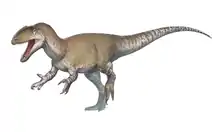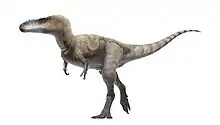| Siamotyrannus Temporal range: Early Cretaceous, | |
|---|---|
 | |
| Illustration of the pelvic bones and tail vertebrae | |
| Scientific classification | |
| Domain: | Eukaryota |
| Kingdom: | Animalia |
| Phylum: | Chordata |
| Clade: | Dinosauria |
| Clade: | Saurischia |
| Clade: | Theropoda |
| Clade: | Avetheropoda |
| Genus: | †Siamotyrannus Buffetaut et al., 1996 |
| Species: | †S. isanensis |
| Binomial name | |
| †Siamotyrannus isanensis Buffetaut, Suteethorn & Tong, 1996 | |
Siamotyrannus (meaning "Siamese tyrant") is a genus of theropod dinosaur from the early Cretaceous of Thailand.
Discovery and naming
In 1993, Somchai Traimwichanon found a partial skeleton of a large theropod at the Phu Wiang 9 site in Khon Kaen.
In 1996, Eric Buffetaut, Varavudh Suteethorn and Haiyan Tong named and described the type species Siamotyrannus isanensis. The generic name is derived from the old Thai kingdom of Siam, and a Latinised Greek tyrannus, meaning "tyrant", in reference to a presumed membership of the Tyrannosauridae. The specific name is derived from Thai isan, "northeastern part", referring to the provenance from northeast Thailand.[1]
The holotype, PW9-1, was found in the Sao Khua Formation, dating from the Berriasian-Barremian. It includes the left half of the pelvis, five rear dorsal vertebrae, the sacrum with five sacrals, and thirteen front tail vertebrae.[1] In 1998, a tibia and some individual teeth were referred to the species.[2]
Description
Siamotyrannus is a large theropod. Buffetaut estimated its length at seven meters. In 2010, Gregory S. Paul estimated the length at 6 meters (20 ft), the weight at 500 kg.[3] In 2016 Molina-Pérez and Larramendi gave a higher estimation of 10 meters (33 ft) and 1.75 tonnes (1.93 short tons).[4] A possible autapomorphy, unique derived trait, is the possession of two vertical ridges on the ilium. The second and third sacrals are strongly transversely flattened.
Classification
As evidenced by its name, it was originally thought to be a tyrannosauroid and even a tyrannosaurid,[1] though due to lacking some of the primary tyrannosauroid synapomorphies that define the clade, its position here is not certain.[5] Some analyses have categorized Siamotyrannus as a primitive carnosaur rather than a basal tyrannosauroid, and it has several features that may determine it to be an allosaurid or a sinraptorid.[6] In 2012 Matthew Carrano e.a. found a position in the Metriacanthosaurinae.[7] Later studies considers its position uncertain within Avetheropoda, finding it to be either an allosauroid or a primitive coelurosaur.[8]
References
- 1 2 3 Buffetaut, E.; Suteethorn, V.; Tong, H. (1996). "The earliest known tyrannosaur from the Lower Cretaceous of Thailand". Nature. 381 (6584): 689–691. doi:10.1038/381689a0. S2CID 7350556.
- ↑ Buffetaut, E. and Suteethorn, V., 1998, "Early Cretaceous dinosaurs from Thailand and their bearing on the early evolution and biogeographical history of some groups of Cretaceous dinosaurs", In: Lucas, Kirkland and Estep, (eds.). Lower and Middle Cretaceous Terrestrial Ecosystems. New Mexico Museum of Natural History Bulletin 14. p. 205-210
- ↑ Paul, G.S., 2010, The Princeton Field Guide to Dinosaurs, Princeton University Press p. 91
- ↑ Molina-Pérez and Larramendi (2016). Récords y curiosidades de los dinosaurios Terópodos y otros dinosauromorfos. Barcelona, Spain: Larousse. p. 262.
- ↑ Rauhut, Oliver W. M. Special Papers in Palaeontology: The Interrelationships and Evolution of Basal Theropod Dinosaurs (No. 69). The Palaeontological Association: 2003
- ↑ Holtz, Thomas R. et al. (2004). "Basal Tetanurae." In: Weishampel, David B.; Dodson, Peter; and Osmólska, Halszka (eds.): The Dinosauria, 2nd, Berkeley: University of California Press. p. 101 ISBN 0-520-24209-2
- ↑ Carrano, M. T.; Benson, R. B. J.; Sampson, S. D. (2012). "The phylogeny of Tetanurae (Dinosauria: Theropoda)". Journal of Systematic Palaeontology. 10 (2): 211–300. doi:10.1080/14772019.2011.630927. S2CID 85354215.
- ↑ Samathi, A.; Chanthasit, P.; Martin Sander, P. (May 2019). "Two new basal coelurosaurian theropod dinosaurs from the Lower Cretaceous Sao Khua Formation of Thailand". Acta Palaeontologica Polonica. 64 (2): 239–260. doi:10.4202/app.00540.2018.

.jpg.webp)












